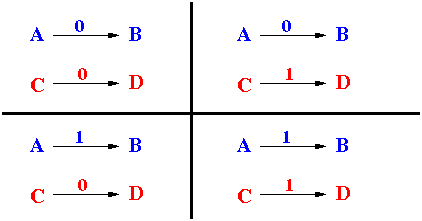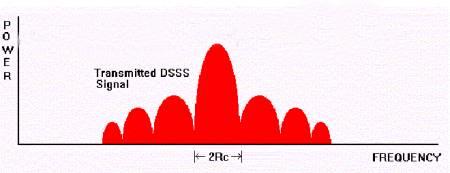- Normal way to use
radio waves (wireless)
to communicate:
- The nodes set their
transmitter and
receiver to
the same frequency
- The message is transmitted using the selected frequency
I.e.: it's like tuning your radio to one station and listen....
- The nodes set their
transmitter and
receiver to
the same frequency
- Disadvantage:
- When another node uses the same frequency and transmits, there will be collisions
- Battlefield communication:
- Soldiers at the front line use radio communication to report the situation back to the head quarters (tug away safely behind many line of defenses)
- Counter Intelligence
measure: Jamming:
- To prevent soldiers from reporting the situation on the battlefield, a strong jamming signal transmitted on the same frequency is used.
- Anti-Jamming commnucation:
- As counter-measure to
the jamming, the military has
develop the
spread-spectrum communication
technique
For more info: click here
- As counter-measure to
the jamming, the military has
develop the
spread-spectrum communication
technique
- Spread spectrum transmission:
- Spread-spectrum transmission:
transmits a signal using
multiple frequencies
I.e.: the data is spread across different frequencies
- Spread-spectrum transmission:
transmits a signal using
multiple frequencies
- Techniques
used to achieve
"spread spectrum" transmission:
- Frequency hopping
- Direct sequence
- Frequency hopping
- The frequency hopping
spread spectrum (FHSS)
transmission technique:
- The sender and receiver first agree
on a list of frequences:
f1 f2 f3 f4 ... fN
- The sender and receiver
must agree on
a random sequence:
r1 r2 r3 r4 .... (indefinitely long)This can be achieve by using the same seed in a common random number generator.
- Sender:
- Send the
first bit of the message on
frequence
fr1
- Send the
bit 2 of the message on
frequence
fr2
...
- Send the
first bit of the message on
frequence
fr1
- Receiver:
- Receive the
first bit of the message on
frequence
fr1
- Receive the
bit 2 of the message on
frequence
fr2
...
- Receive the
first bit of the message on
frequence
fr1
- The sender and receiver first agree
on a list of frequences:
- Graphically:

Explanation:
- The picture above shows
4 different times
that FHSS transmits
- Each transmission uses a different frequency
NOTE:
- Some data will still
be lost
due to jamming
- Data sent on frequencies that is close to the jamming signal will be lost
But: most of the transmitted data will be received !!!
- Fortunately,
voice communication is
highly "redundant":
- It is possible to lose part of the conversation and the rest is still comprehensible !!!
- The picture above shows
4 different times
that FHSS transmits
- Applications:
- Anti-jamming:
- A jam-signal will
corrupt transmissions in
a certain range of frequencies
- By "spreading" the
transmission over
multiple frequencies,
most of the
transmitted data will be
received correctly
- With error correction or redundant transmissions (transmit data multiple times), we can overcome jamming with spread spectrum
- A jam-signal will
corrupt transmissions in
a certain range of frequencies
- Anti-eavesdropping:
- An eavesdropper
tunes (= listens) in
to the transmission in
a certain frequency
- By "spreading" the
transmission over
multiple frequencies,
most of the transmitted information will
not be eavesdropped
- An eavesdropper
tunes (= listens) in
to the transmission in
a certain frequency
- Anti-jamming:
- Note:
- This technique is
high effective in
protecting
audio transmission
- Fact:
- Audio is highly redundant
(you don't need to hear everything to understand what is communicated)
- So losing a few bits
in the audio stream
due to jamming
will not
prevent the communication
- Having a few bits "stolen" will not allowed the thief to understand the entire conversation
- This technique is
high effective in
protecting
audio transmission
- Frequency-hopping spread spectrum - Wikipedia: click here
- Definitions:
- Pseudo Noise (PN) code =
a random sequence of
N bits
( The number of 0's and 1's in the PN code should be approximately equal)
- Chip =
a popular name for the
PN code
- Chip length = the number of bits in the chip (PN code)
The Direct Sequence spread spectrum (DSSS) transmission technique:
- The sender and the
receiver select a common
Pseudo Noise (PN) code:
- Sender:
- Transmit "1": use the chip (PN code)
- Transmit "0": use the inverse of the chip (PN code)
Example:

- Receiver: (decoding algorithm):
- Receive N bits
(N = the chip length)
- If a majority of the
received N bits
matches the
PN code:
- The receiver has received a "1" bit
- If a majority of the
received N bits
fails to matches the
PN code:
- The receiver has received a "0" bit
- Receive N bits
(N = the chip length)
- Pseudo Noise (PN) code =
a random sequence of
N bits
- Suppose the nodes A and B uses
the following PN code:
PN code = 0011011
- If the node B receives:
B: 1011011
then node B will decode as follows:
received: 1011011 PN code: 0011011 XOR ------------------ 1000000 NOT ------------------ 0111111 Majority = 1 ===> 1(You can compare the received data with the PN code using an Exclusive OR operation)
- The interference of
radio transmission is
very complex
- I will present a simplified explanation on how the PN code can overcome "jamming" (collision) from another transmission.
- Simplification:
- I will use Amplitude Modulation
to show you that
the PN code can
overcome collisions
(In a later section, I will explain what is really going on; but not very in depth --- this is a Electrical Engineering subject...)
- I will use Amplitude Modulation
to show you that
the PN code can
overcome collisions
- PN code using
Amplitude Modulation:
- Suppose node A and B uses this
PN code:
A/B's PN code = 0011011
- Using Amplitude Modulation,
the PN code is
transmitted using this
wave:

- Suppose node A and B uses this
PN code:
- Effect of collision (jamming):
- Suppose we has 2 pairs of
sender/receiver:
- A/B uses
PN code = 0011011
- C/D uses PN code = 1011010
- A/B uses
PN code = 0011011
-
Suppose
A ⇒ B
and
C ⇒ D
simultaneously:
- A sends "1" to B (i.e.: A will send 0011011 --- because its PN code "0011011")
- C sends "1" to D (i.e.: C will send 1011010 --- because its PN code "1011010")
Graphically: (using Amplitude Modulation)

- Physics:
- Simultaneous waves result in
super-imposition
(I.e.: the amplitudes are added together)
The receivers will "hear" (receive) the following FONT color="darkmagenta">pattern:

When both receiver try to decode the reception (using Amplitude Modulation, they will receive the corrupted pattern:
- 1011011
Explanation:
- A large amplitude will be decoded as 1
- A low amplitude will be decoded as 0
- Simultaneous waves result in
super-imposition
- Suppose we has 2 pairs of
sender/receiver:
- Observation:
- Using amplitude modulation,
simultaneous transmissions will result in
or-ing the
data bits
- From the above example:
A --> B: 0011011 C --> D: 1011010 OR ------------------- 1011011 <---- received by B and D
- Using amplitude modulation,
simultaneous transmissions will result in
or-ing the
data bits
- Consider
all possible scenarios
that the transmissions
A ⇒ B and
C ⇒ D
can interact
with each other:
- At the bit level, the senders A and C can transmit either a "1" bit or a "0" bit
- There are then
4 possible
interference patterns:

Namely:
- A transmits 0 to B and C transmits 0 to D at the same time
- A transmits 0 to B and C transmits 1 to D at the same time
- And so on...
Let's consider for each case whether the receivers B and D can decode the transmission correctly....
- The following figure consider these
interferences:
- A
sends "1"
and
C
sends "1"
(at the same time)
- A sends "0" and C sends "0" (at the same time)
What the receivers B and D will decode:

Result:
- Both receivers B and D will decode correctly despite the interference
- A
sends "1"
and
C
sends "1"
(at the same time)
- The following figure consider these
interferences:
- A
sends "1"
and
C
sends "0"
(at the same time)
- A sends "1" and C sends "0" (at the same time)
What the receivers B and D will decode:

Result:
- Again, both receivers B and D will decode correctly despite the interference
- A
sends "1"
and
C
sends "0"
(at the same time)
- Conclusion:
- Using these
specific chips,
each
sender/receiver pair
is able to
decode the transmitted bit correctly.
- Therefore,
the transmitting nodes
are able to
share
the transmission medium
(The direct-sequence spread spectrum has the "anti-jamming" property !!!).
- Using these
specific chips,
each
sender/receiver pair
is able to
decode the transmitted bit correctly.
- The real explanation is
much more complex...
- Sender:
- Recall that a digital signal
(e.g.: 10101010...) is
composed of
many different frequencies
(see:
click here)

- The result of using the
Psuedo Noise (PN) code
to transmit
the data is:
- Transmit the data using a spectrum of frequencies
The signal strength used in DSSS transmissions look like this:

- Recall that a digital signal
(e.g.: 10101010...) is
composed of
many different frequencies
(see:
click here)
- Receiver:
- The receiver will tune in to the same set of frequencies defined by the Pseudo Noise (PN) code to pickup the data
- Different PN codes
can be alike or
different
- The measure of
"likeness" is
the correlation,
defined as:
∞ 1 / Rcorr(τ) = --- | pi(t) pj(t+τ) dt (See: click here) T / 0The function pi(t) and pj(t) are the wave forms of the two PN codes.
(Don't worry, you don't need to know the details of correlation - it's there for completeness sake....)
- The correlation function
has the following properties:
- 0 ≤ Rcorr ≤ 1
- Rcorr = 1 if the PN codes ate identical
- Rcorr = 0 if the PN codes ate uncorrelated
Intermediate values (between 0 and 1) indicate how much the codes have in common.
- Property:
- If 2 PN codes are highly correlated, their collisions will be more likely to cause decoding errors
- Fact:
- Direct Secquence Spread Spectrum (DSSS) can allow multiple sender/receiver to share the broadcast transmission medium
Tjis sharing technique has a name....
- Definition:
- Code Division Multiplexing (CDM) = sharing a broadcast transmission medium using PN code transmission
- Recall we have learn
2 medium sgaring techniques previously:
- Time Division Multiplexing (TDM)
- Frequency Division Multiplexing (FDM)
CDM is the third way to share a transmission medium